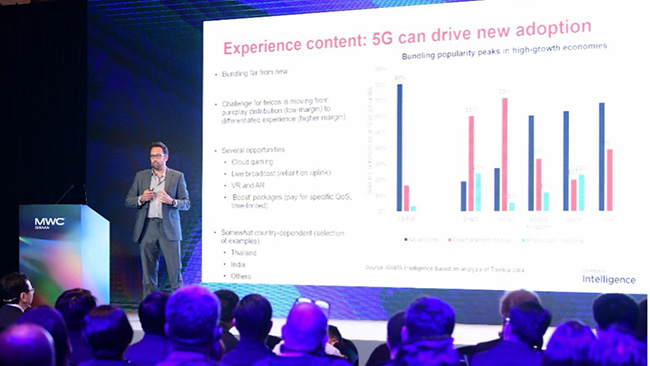Press Release: Over the past five years, 5G has created remarkable commercial value and social benefits. Pioneering operators have enjoyed the dividends of the first wave of 5G commercial use through traffic monetization. With the commercial use of 5G-A and the advent of the mobile AI era, new services have emerged and the demand for experience and differentiated guarantees has increased. In addition, operators are also facing the pressure of slowing mobile traffic growth and revenue growth, and urgently need to open up a new growth curve. The shift from traffic monetization to experience monetization has become an inevitable trend.
At MWC Shanghai 2024, GSMA worked with industry partners to hold a conference session titled “The Rise of 5G Advanced: From Commercialization to Social Success”. The session focused on the opportunities and challenges brought by 5G-A and provided deep insights into new opportunities for users’ experience requirements. The trends of MNOs’ innovative pricing and experience-based monetization were also discussed in depth, providing new reference materials for the future development of the mobile industry in the 5G-A era.
Innovative business models will spur new 5G growth
According to a GSMA Intelligence study, global mobile traffic and operator revenue growth are slowing. Global mobile revenue growth is expected to be around 3.8% in 2023, then fall to 2% in 2029. In the long term, operators cannot rely on traffic growth itself to justify higher fee premiums. The traditional single-traffic monetization model is finding it increasingly difficult to support sustained and rapid revenue growth. Operators need to change the single-traffic pricing mode and implement multi-dimensional monetization business models through innovative fee design to further stimulate the potential of 5G and inject new vitality into the continued revenue growth of the 5G industry.
The multidimensional capabilities of 5G will enable monetization of differentiated experiences.
In the 5G-A era, new services such as live broadcasting (uplink), cloud gaming (low latency), streaming media (downlink), naked-eye 3D, and VR/AR impose differentiated requirements on network capabilities. And 5G-A capabilities such as high speed and low latency on uplink and downlink can support the guarantee of this new service experience. Therefore, operators can take advantage of the multi-dimensional capabilities of 5G-A to innovate multi-dimensional business models. According to GSMA Intelligence, the core applications for consumers are gaming and streaming media. Users need high-performance networks to ensure a good user experience for these applications. In key 5G markets such as China and South Korea, ultra-high definition (UHD) video-based content is one of the most consumed categories of 5G services, and consumers are willing to pay extra for a better user experience. In the future, the revolution in the content ecosystem brought about by AIGC applications such as Sora will impose new requirements on the uplink and downlink capabilities of mobile networks, providing more room for operators to monetize differentiated experiences based on the multi-dimensional capabilities of 5G.
Pioneering businesses move into the era of “experience monetization”
In the Asia-Pacific region, major 5G operators in China and Thailand have actively invested in multi-dimensional experience monetization models. For uplink experience, Guangdong China Unicom launched a 5G live broadcast package, offering live bloggers a guaranteed ultra-fast uplink rate of 150Mbit/s or 200Mbit/s. It is expected that the number of live package users will reach 500,000 by the end of the year. China Mobile, the world’s first 5G-A commercial deployment base, has launched multiple 5G-A experience packages and added new service rights such as cloud phone and new calls, allowing consumers to enjoy faster and lower latency mobile network services.
At the end of 2023, AIS Thailand released the Living Network Hotspot Acceleration Add-on Package, which includes three modes: Boost (high speed), Game (low latency) and Live (uplink). The package ensures differentiated user experience through deterministic differentiation and increases ARPU by 23%.
In the Middle East, typical MNOs are exploring new avenues for monetizing experiences through FWA users. Tiering. For example, UAE operator du released an FWA Game Acceleration package during SAMENA to enable a differentiated low-latency experience on select games and to offer OTT membership entitlements such as Disney+. Speed tier packages for fixed home broadband services have become a popular choice for operators to launch FWA services globally.
In addition, the open gateway initiative proposed by the GSMA also provides new options for mobile operators to monetize network capabilities to third-party OTT service providers. Through open APIs, carriers can integrate and expose network capabilities (such as network quality) to third parties such as cloud providers and video stream service providers, significantly reducing development and knowledge costs. OTT vendors will incorporate 5G capabilities purchased from carriers into their own products to rapidly build new applications and services that are better and more convenient. For example, the Quality-on-Demand API allows application developers to optimize QoS configurations to provide a better network experience for key application consumers such as online games and real-time streaming media. The differentiated pricing model will bring increased revenue and achieve a win-win situation among carriers, OTT providers and users. In the future, with the advent of the mobile AI era, more emerging applications and fully upgraded multi-dimensional network capabilities will complement each other. The experience monetization model will help operators continuously unleash the momentum of 5G-A and achieve greater business success.


